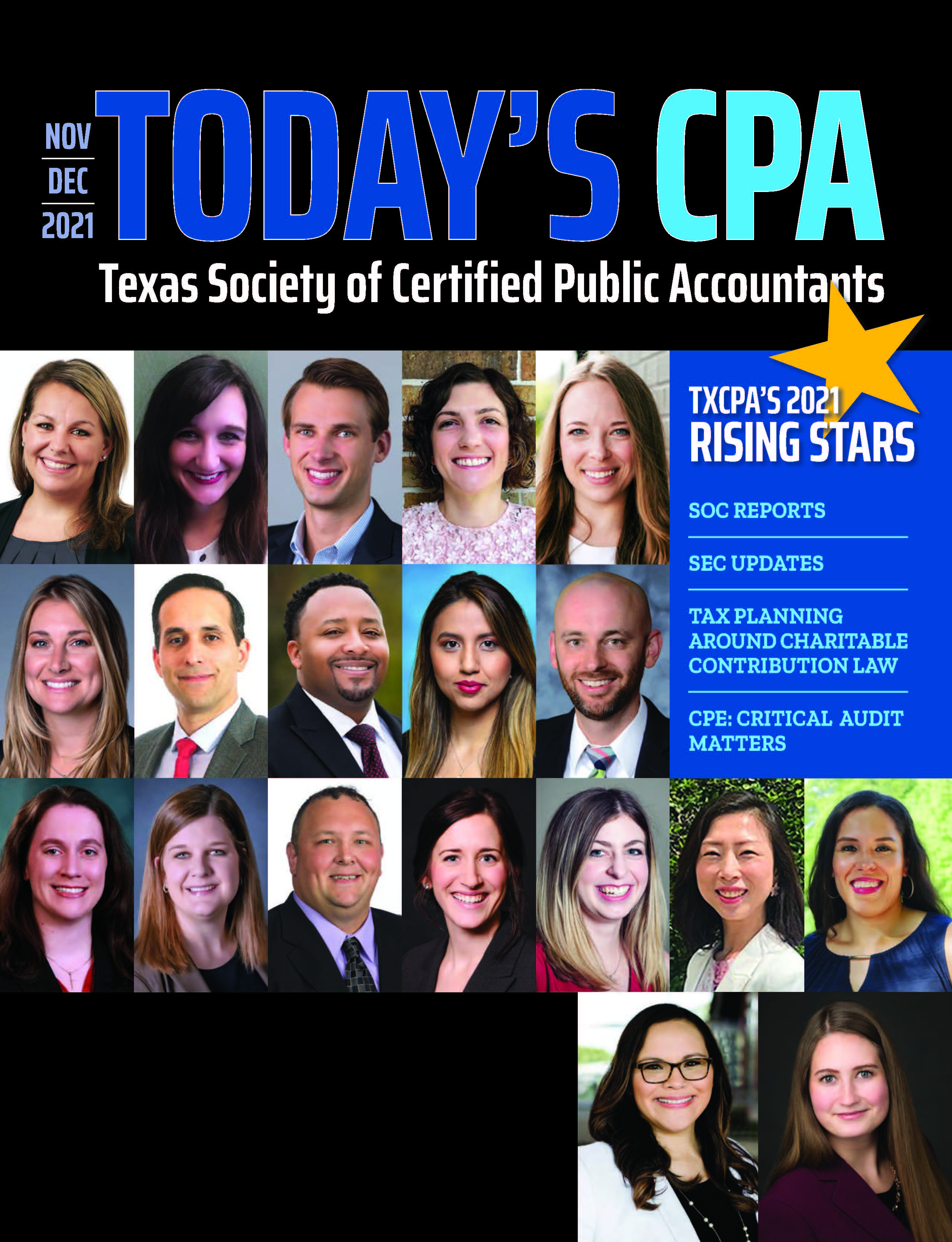Helping Auditors Add Critical and Key Audit Matters to Audit Reports
By Alan Reinstein, DBA, CPA, and Myles Stern, Ph.D., CMA
Auditing standards boards globally seek to enhance the information content and transparency of audit reports. In 2015, International Standard on Auditing 701, Communicating Key Audit Matters in the Independent Auditor’s Report was issued by the International Auditing and Assurance Standards Board (IAASB). Adopted in several countries, this standard requires key audit matter (KAM) disclosure for listed companies, or when required by a specific law or regulation. The standard also permits the auditor of a non-listed company to disclose KAMs voluntarily. All companies that wish to comply with IASB standards should adhere to the provisions of Standard 701.
Public Company Accounting Oversight Board (PCAOB) Release 2017-001, The Auditor’s Report on an Audit of Financial Statements When the Auditor Expresses an Unqualified Opinion, required auditors of large accelerated filers of SEC reports to describe their critical audit matters (CAMs) in auditors’ reports for annual periods ending on or after June 30, 2020. This standard applies to all filers for annual periods ending on or after December 15, 2021.
While many audit firms have already reported CAMs, all auditors should recognize that these communications to the audit committee provide information that:
• Relates to accounts or disclosures that are material to the financial statements, and
• Involves especially challenging, subjective or complex auditor judgment.
While not listing required CAMs or identifying potentially significant risks to include in a CAM, PCAOB asks auditors to assess which challenging, subjective or complex judgments constitute CAMs. AS 3101.12 includes the following criteria for possible CAMs:
• The auditor’s assessment of risks of material misstatements;
• The degree of auditor judgment related to areas in the financial statements that involve management applying significant judgment or estimation, including estimates with significant measurement uncertainty;
• The nature and timing of significant unusual transactions and the extent of audit effort and judgment related to these transactions;
• The degree of auditor subjectivity in applying audit procedures to address the matter or assess the results of the procedures;
• The nature and extent of audit effort required to address the matter, including the extent of specialized skill or knowledge needed or the nature of consultations outside the engagement team regarding the matter; and
• The nature of audit evidence obtained regarding the matter.
New Non-Issuers Auditor’s Report KAM Requirements
In 2019, the Auditing Standards Board (ASB) issued SAS No. 134 (AU-C 701), Auditor Reporting and Amendments, Including Amendments Addressing Disclosures in the Audit of Financial Statements. Effective for audits of financial statements for periods on or after December 15, 2021 (with earlier application allowed), auditors of non-issuers may include key audit matters (KAMs) in the auditor’s report “that, in the auditor’s professional judgment, were of most significance in the audit of the financial statements of the current period. Key audit matters are selected from matters communicated with those charged with governance.”
KAMs can relate to material accounts or disclosures, or especially challenging, subjective or complex judgments to communicate to the audit committee. Specifically, auditors should report KAMs only if they are “engaged to do so.” Presumably, some users of these audited financial statements – perhaps lenders or audit committee members – will find KAM reports helpful and will press the company to engage its independent auditor to report on KAMs. Also, companies considering public offerings may seek KAM reports. Still, while the demand for KAMs is unknown, audit reports would normally exclude KAMs unless the engagement letter requires such procedures.
KAMs will require much auditor attention in areas of high assessed risk of material misstatement or of significant management judgment, such as significant events or transactions. AU-C 701 states that KAM reports do not substitute for required financial statement disclosures that are management’s responsibility, expressing a modified opinion when required, reporting going concern issues, or issuing a separate opinion on individual matters.
Before offering suggestions for auditors who may soon need to report CAMs/KAMs for the first time, we make two observations. One, both PCAOB Release 2017-001 and SAS 134 are comprehensive pronouncements dealing with many aspects of audit reports. Two, while some reporting details differ, critical (CAM) and key (KAM) audit matters are conceptually identical.
Sources of Suggested CAM/KAM Wording
PCAOB’s staff publication, “Implementation of Critical Audit Matters: The Basics” (https://pcaobus.org/Standards/Documents/Implementation-of-Critical-Audit-Matters-The-Basics.pdf), provides general CAM reporting guidance.
Further resources for auditors’ CAM and KAM reports include the SEC’s Electronic Data Gathering, Analysis, and Retrieval (EDGAR) system (https://www.sec.gov/edgar/searchedgar/companysearch.html); a commercial product, Audit Analytics database (AADB); and annual reports from company websites.
The first source provides information by company name or Standard Industry Classification, and the second summarizes all publicly available CAM disclosures, including 6-digit North American Industry Classification System (NAICS) and 70 accounting issues (e.g., going concern, intangible assets and goodwill impairment) as classified by the Audit Analytics research staff. Because KAM reporting is not yet implemented and such reports likely will not be made public, auditors should rely on existing CAM reports for guidance.
While not endorsing the AADB, we used its content to find many interesting ideas to assist auditors in developing their own CAMs/KAMs. We viewed 4,513 CAMs on 2,668 audit reports of client years ending from June 2019 through November 2020, where Big Four firms provided 4,152 CAMs (92.0% of the total) on 2,446 (91.7%) audit reports. We found that the number of CAMs per audit varied little across industry sectors, using 2-digit NAICS codes. Excluding industries with less than 12 audit reports (to avoid distortions from small samples), auditors issued 1.69 CAMs per audit report, ranging from 1.52 (Sector 481 “Other Services”) to 1.92 (Sector 61 “Educational Services”).
Regarding specific accounting issues, 13.6% of all CAMs involved goodwill or goodwill and intangible assets. Some major industries that disclosed this topic included 27.3% for Sector 81 “Other Services,” 27.1% for Sector 42 “Wholesale Trade,” and 22.2% for Sector 56 “Administrative and Support and Waste Management and Mediation Services.”
Next, 11.4% of all CAMs showed revenue from customer contracts issues, including 36.4% for Sector 54 “Professional, Scientific, and Technical Services,” 26.8% for Sector 51 “Information,” and 21.5% for Sector 23 “Construction.” Business combinations appeared in 11.2% of all CAMs, especially 30.0% for Sector 71 “Arts, Entertainment, and Recreation,” 21.7% for Sector 61 “Educational Services,” and 15.6% for Sector 62 “Health Care and Social Assistance.”
Exhibit 1 presents our cross-tabulation of CAM topics by industry sectors. Due to space limitations, we deleted from this table industry sectors and CAM topics with fewer than 20 entries, leaving 4,187 CAMs from the original 4,513. We found that virtually all CAM reports refer to associated financial statement footnotes. Each CAM report generally describes:
1) The nature of the CAM, related footnote(s) and pertinent lines in the financial statements;
2) Why the topic is critical to the audit;
3) The audit procedures performed regarding the topic (such as using fair value specialists to assess the reasonableness of management’s forecasts of future cash flows); and
4) Outcomes of the audit procedures and other key observations about the matter.
As shown below, the auditor should not provide a separate opinion on the topic.
Required Language for CAMs
PCAOB requires an auditor issuing CAMs to use this introductory language:
The critical audit matters communicated below are matters arising from the current period audit of the financial statements that were communicated or required to be communicated to the audit committee and that: (1) relate to accounts or disclosures that are material to the financial statements and (2) involved our especially challenging, subjective, or complex judgments. The communication of critical audit matters does not alter in any way our opinion on the financial statements, taken as a whole, and we are not, by communicating the critical audit matters below, providing separate opinions on the critical audit matters or on the accounts or disclosures to which they relate.
The ASB requires similar introductory language for KAMs:
Key audit matters are those matters that were communicated with those charged with governance and, in the auditor’s professional judgment, were of most significance in the audit of the financial statements of the current period. These matters were addressed in the context of the audit of the financial statements as a whole, and in forming the auditor’s opinion thereon, and the auditor does not provide a separate opinion on these matters.
PCAOB also requires auditors determining that no CAMs exist to state:
Critical audit matters are matters arising from the current period audit of the financial statements that were communicated or required to be communicated to the audit committee and that: (1) relate to accounts or disclosures that are material to the financial statements and (2) involved our especially challenging, subjective, or complex judgments. We determined that there are no critical audit matters.
Summary of CAM Disclosures
We next summarize results reported in the Center for Audit Quality’s Critical Audit Matters: A Year in Review, https://www.thecaq.org/wp-content/uploads/2020/12/caq-critical-audit-matters-year-in-review-2020-12.pdf. Early CAM adopters focused on four key areas: taxes, goodwill/intangibles, contingent liabilities, and revenue. These likely arose from their often challenging, subjective and materiality assessment bases. Other areas include sales returns and analyses, business combinations, pensions, and asset retirement. We comment below on topics from both studies – ours and the Center for Audit Quality’s.
First, tax CAMs focused on such areas as the somewhat subjective impact of new federal tax laws (e.g., the Tax Cuts and Jobs Act), deferred tax asset unrecognized benefits and accounting for income taxes. Next, goodwill/intangibles often involve significant management and auditor judgment relating to impairment and amortization. Auditors often noted different assumptions, reporting units or difficult to measure intangible assets.
CAMs regarding contingent liabilities include estimating legal contingencies, requiring auditing judgments on how management considered multiple potential outcomes and identifying the most likely outcome. Also, CAMs involving revenue recognition cover such areas as subscription services, long-term contracts and royalties. Interesting disclosures also arose based upon specific industries (e.g., financial and energy services), changing regulatory landscapes and the need to hire experts to assess environmental matters.
Examples of CAM Disclosures
For illustrative purposes, here are parts of accelerated-filer CAMs for three different accounting issues in three different industries.
Accounting for Impairments, Technology Industry (Palo Alto Networks)
As of July 31, 2019, the Company completed the acquisition of Demisto, Inc. for net consideration of $474.2 million, the acquisition of RedLock Inc. for net consideration of $158.2 million, and the acquisition of Twistlock Ltd. for net consideration of $378.1 million. As discussed in Note 6 to the consolidated financial statements, the Company accounted for these acquisitions as business combinations.
Auditing the accounting for acquisitions was complex due to the significant estimation uncertainty in determining the fair values of identified intangible assets, which primarily consisted of developed technology of $156.7 million and customer relationships of $27.6 million. The significant estimation uncertainty was primarily due to the sensitivity of the respective fair values to underlying assumptions about future performance of the acquired businesses and due to the limited historical data on which to base these assumptions.
The significant assumptions used to form the basis of the forecasted results included revenue growth rates and technology migration curves. These significant assumptions were forward-looking and could be affected by future economic and market conditions.
Accounting for Income Taxes (Estée Lauder)
As discussed in Note 2 to the consolidated financial statements, the Company is subject to income tax in each tax jurisdiction in which it operates. The Company maintains offices in over 50 countries and has key operational facilities located inside and outside the United States that manufacture, warehouse or distribute goods for sale in approximately 150 countries and territories.
We identified the evaluation of the accounting for income taxes as a critical audit matter. The Company’s global structure required complex auditor judgment to evaluate the Company’s interpretation and application of tax laws in relevant jurisdictions and the income tax impact of the legal entity ownership structure.
Goodwill Impairment Testing, Wholesale Drug Industry (Cardinal Health, Inc.)
At June 30, 2019, goodwill related to the Company’s Medical segment, including the Medical Unit, was $5.7 billion. As discussed in Note 4 to the consolidated financial statements, goodwill is tested for impairment at least annually at the reporting unit level.
Auditing management’s annual goodwill impairment test for the Medical Unit was challenging because this reporting unit’s fair value had an impairment in the previous year and there is significant judgment required in determining the fair value of the reporting unit.
In particular, the fair value estimate was sensitive to significant judgmental assumptions, including the revenue growth rate, gross margin, distribution, selling, general and administrative expenses, and company-specific risk premium, which are affected by expectations about future market or economic conditions.
Important Information for Financial Statement Users
CAMs and KAMs are challenging, subjective and complex areas, where auditors provide useful information that many financial statement users will analyze carefully. While conceptually similar, CAM reporting is mandatory while KAMs will be disclosed only when specifically included in the audit engagement.
Due partly to the newness of the standards and the limited authoritative guidance, it is difficult to identify and communicate CAMs/KAMs.
Audit firms that will now report CAMs/KAMs for the first time should examine existing CAMs from actual audit reports, particularly for topics and industries pertinent to their clients.
These CAMs will help auditors decide whether a topic should be a CAM/KAM and how to report it, thus helping financial statement users to better understand the audit process, as well as the key decisions of the auditors.
About the Authors:
Alan Reinstein, DBA, CPA, is George R. Husband Professor of Accounting at Wayne State University in Detroit, Michigan. Contact a.reinstein@wayne.edu.
Myles Stern, Ph.D., CMA, is Associate Professor of Accounting at Wayne State University in Detroit, Michigan. Contact m.stern@wayne.edu.

















